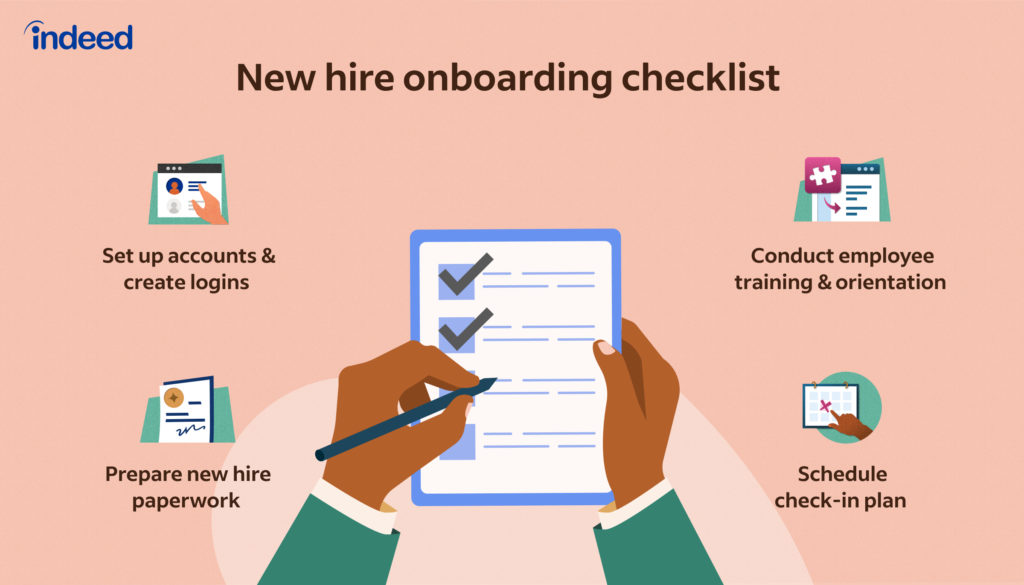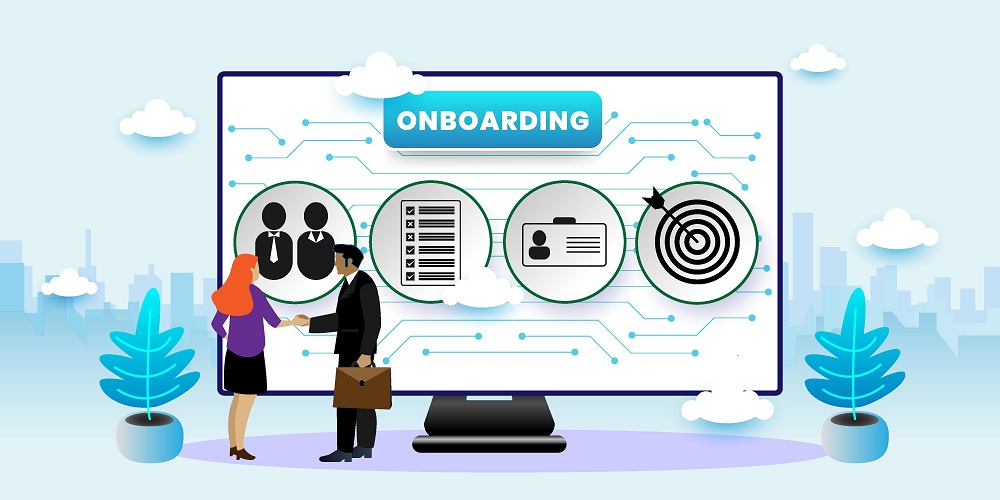In today’s dynamic business landscape, a high turnover rate can be a significant problem, often caused by ineffective or nonexistent inboarding processes. When new employees feel disconnected or unclear about their roles and the company culture, they may quickly disengage and seek opportunities elsewhere.
To tackle this problem, businesses are increasingly adopting a structured inboarding strategy.
Inboarding goes beyond traditional orientation; it’s a comprehensive approach to fully integrate new hires into the organizational framework, promoting a deep understanding of the company’s values, vision, and operating principles.
Through personalized training programs, mentorship opportunities, and continuous support, inboarding sets up employees for long-term success and satisfaction, ultimately boosting retention rates and fostering a positive, productive workplace culture.
Starting on the right foot with a solid inboarding process is beneficial for the employees and a strategic investment in the company’s future.
What Is Inboarding?
Inboarding is an evolved form of employee onboarding. Here’s what makes inboarding different, with specific examples:
- Personalized Training: Unlike generic training materials, companies like Google provide new hires with customized learning plans. This might include interactive modules tailored to an individual’s role or team-specific projects that encourage a deeper connection with colleagues.
- Mentorship: Organizations such as Boeing pair new employees with experienced mentors. This relationship offers guidance and insider knowledge to accelerate a new hire’s integration into the company’s culture and work processes.
- Ongoing Support: Unlike traditional onboarding that stops after the first week or month, inboarding includes continuous support. Salesforce, for example, has a “Trailhead” platform with resources available to employees at any point in their career to aid continuous growth and adaptation within the company.
- Feedback Loops: Companies with robust inboarding processes like Zappos implement regular check-ins to ensure the new hire is aligning well with company values and getting the support they need and to receive feedback on the inboarding process itself. These may include:
- Weekly one-on-one meetings with a direct supervisor.
- Monthly group sessions with other new hires to discuss shared experiences.
- Quarterly reviews to reflect on progress and set future goals.
Inboarding ensures new hires understand their role and become engaged, empowered, and embedded members of their new work family, ready to contribute and grow.
Inboarding vs Onboarding
While both inboarding and onboarding share the goal of helping new employees transition into their roles, they differ in approach and depth. Here are some of the key distinctions:
Duration and Intensity:
- Onboarding typically covers the basics during the first few days or weeks of employment, focusing on paperwork, basic training, and initial introductions.
- In contrast, inboarding is a more intensive process that often extends for several months, ensuring employees develop a profound understanding of and alignment with the company’s mission and culture.
Approach to Integration:
- Onboarding might give a broad overview of company operations, which can sometimes be too general to be practical on a day-to-day basis.
- Inboarding invests in a tailored experience, with specific examples being:
- Customized pathways for role-based proficiency development.
- Long-term mentorship programs that align new hires with company veterans.
Support Structures:
-
- Traditional onboarding often has a finite set of resources and tends to taper support fairly quickly once the employee starts.
- Inboarding initiatives, like the one at Adobe that involves an “Experience-a-Day” journey, provide ongoing resources that employees can access at any point, promoting continual learning and adjustment.
Cultural Immersion:
-
- Onboarding may introduce the company’s values and culture but generally leaves the deeper cultural immersion to happen organically over time.
- Inboarding, such as Etsy’s emphasis on community integration, intentionally involves new hires in cultural practices, social events, and company-wide projects that nurture a sense of belonging.
While onboarding might resemble a brief orientation, inboarding resembles a comprehensive apprenticeship, carefully guiding new hires into becoming fully-fledged, engaged members of an organization’s family.
Use Cases for Inboarding
Inboarding can be applied across various scenarios to enhance the employee experience and reinforce company culture. Here are a few use cases where inboarding shows its strengths:
- Career Transitions: When employees are promoted or transferred, inboarding programs can help them acclimate to new responsibilities and team dynamics. For example, employees shifting into leadership roles at IBM participate in transition inboarding that prepares them for their new functions and leadership expectations.
- Mergers and Acquisitions: Integrating teams from different corporate cultures is crucial after a merger or acquisition. Inboarding can smooth out this process. For instance, when Microsoft acquired LinkedIn, they employed inboarding strategies to align LinkedIn’s employees with Microsoft’s culture and systems while preserving core LinkedIn values.
- Returning Employees: Individuals returning from extended leave, such as maternity or sabbatical leave, can benefit from an inboarding process that updates them on any changes and re-engages them with their team. Deloitte has implemented “returnship” programs that serve as inboarding for returning employees, easing the transition into the workforce.
- Remote Workforce: A robust inboarding process is essential for remote employees who can’t experience office culture in person. Companies like Zapier, which operates remotely, have constructed virtual inboarding experiences that recreate the office dynamic online and build strong, interconnected remote teams.
In these cases, inboarding is a versatile and effective tool in fostering employee satisfaction and retention and nurturing a vibrant, unified company culture.
The Importance of Inboarding
In today’s fast-paced business landscape, the significance of inboarding cannot be overstated. Inboarding serves several key functions within an organization:
- Employee Retention: The investment in a thorough inboarding process demonstrates a company’s commitment to its employees, and this investment is often reciprocated through increased loyalty and lower turnover rates. For instance, Google has seen new hires’ retention improve by focusing on the critical first months of employment.
- Productivity Boost: Comprehensive inboarding helps employees hit the ground running. For example, Netflix’s inboarding program is designed to immerse new hires in the company culture and workflow from day one, ramping up productivity quickly.
- Enhanced Engagement: Employees feeling supported and valued from the outset are likelier to be engaged. With its in-depth inboarding sessions, Twitter ensures that employees are engaged and motivated by reinforcing the company’s mission and their role in it.
- Cultural Alignment: When employees are deeply indoctrinated into a company’s culture, as seen at Patagonia, they become strong brand ambassadors inside and outside the company.
To summarize, inboarding ultimately shapes the foundation of an enriched workforce. It is a process that goes beyond simple orientation and extends into a strategic initiative with a far-reaching impact on the organization’s overall health.
7 Key Components of an Inboarding Program
A successful inboarding program encompasses several critical elements, each designed to smoothly integrate new hires into the company fabric. Below, the seven key components are outlined:
Comprehensive Orientation: Start with an in-depth orientation that goes beyond the typical “first day” rundown. This should include:
-
- A detailed tour of the company, including introductions to key team members.
- Access an online portal with company policies, procedures, and cultural resources.
Individualized Learning Plans: Craft learning trajectories customized for each role, ensuring new hires develop the skills and knowledge necessary to excel. This involves:
-
- Assessments are used to determine individual learning styles and requirements.
- A variety of training methodologies, including workshops, e-learning modules, and hands-on projects.
Mentorship and Coaching: Establish a mentorship program connecting new employees with seasoned veterans who can provide guidance, support, and insight into the company’s nuances. This pairing should be thoughtfully curated based on:
-
- Similar career trajectories or backgrounds.
- Complementary skills and personalities.
Regular Feedback and Check-Ins: Implement a structured schedule of check-ins and performance reviews to track progress and address concerns. This might look like:
-
- Weekly one-on-one meetings with a direct supervisor or mentor.
- Formal quarterly reviews to discuss achievements, challenges, and goals.
Cultural Integration Initiatives: Create opportunities for new hires to engage in company culture through a mix of formal and informal events, such as:
-
- Volunteering for company-sponsored community service events.
- Social gatherings, like team lunches or company retreats, embody the company’s values.
Ongoing Training and Professional Development: Offer continuous learning opportunities to encourage growth, including:
-
- Skill development seminars relevant to the industry.
- Access a budget for external courses or conferences pertinent to an employee’s career path.
Health and Well-Being Programs: Recognize that employee satisfaction is linked to holistic well-being by providing programs like:
-
- Wellness resources, such as gym memberships or mindfulness classes.
- Flexible work arrangements that cater to work-life balance.
These components are integral to establishing a comprehensive inboarding strategy that fosters employee engagement, productivity, and long-term retention.
How to Develop an Inboarding Strategy for Your Workplace
When developing an inboarding strategy for your workplace, viewing it as a roadmap for new employee success and satisfaction is important. Here’s how you can craft an effective strategy backed by real-world examples:
Assess Current Onboarding Processes: Analyze your existing onboarding procedures before developing an inboarding strategy. Identify what works well and where gaps exist. For instance, HubSpot conducts regular employee feedback surveys to enhance its onboarding processes.
Set Clear Goals and Objectives: Determine what you want to achieve through inboarding.
-
- Facilitate faster ramp-up to full productivity.
- Ensure cultural assimilation.
- Create a support system for new employees.
Tailor the Program to Company Values: Align the inboarding program with your organizational culture and values. Salesforce, renowned for its “Ohana Culture,” infuses this family spirit into every facet of its inboarding process.
Interactive Learning Experience: Use a blend of learning tools to accommodate different learning styles.
-
- Incorporate e-learning for self-paced study.
- Schedule workshops for collaborative, hands-on experiences.
- Adobe, for example, uses gamification in its training modules to make the learning process more engaging and interactive.
Integrate Technology: Leverage digital platforms for efficient program delivery.
-
- Utilize a central hub like an intranet as a go-to resource for new hires.
- Implement apps like Slack or Trello for easy communication and task management, similar to what companies like Shopify do.
Mentorship and Networking: Establish strong mentorship and peer networking opportunities.
-
- Pair new hires with mentors as done at LinkedIn.
- Organize networking events that mimic Toastmasters clubs for public speaking and leadership development.
Track Progress and Collect Feedback: Implement mechanisms to monitor the effectiveness of the inboarding program.
-
- Regular check-ins and performance analytics.
- Collect feedback through surveys or suggestion boxes as Etsy practices to fine-tune the program.
Continuous Improvement: Always look for ways to improve the inboarding process based on feedback and changing company dynamics. Just as Amazon is known for its culture of innovation, instill a similar mindset when evolving your inboarding strategy.
By meticulously creating an inboarding strategy that acknowledges the unique needs of your workplace while incorporating these practical steps, you’ll be setting up your new employees—and your company—for success. Remember, a thoughtful inboarding program speaks volumes about your company’s commitment to its staff and can become a defining factor in attracting and retaining top talent.

10+ years experience in Marketing and Operations






My brother suggested I might like this website He was totally right This post actually made my day You cannt imagine just how much time I had spent for this information Thanks
This webpage is phenomenal. The brilliant data reveals the proprietor’s interest. I’m awestruck and expect further such astounding sections.